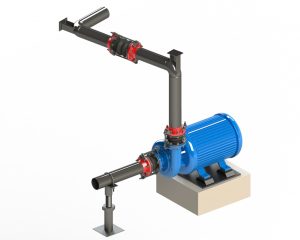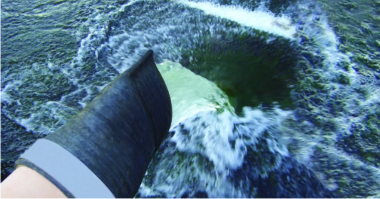Expansion joints are a critical component for any industrial application which includes piping or ducting. With a wide variety of designs and materials to choose from, the correct selection and optimal installation of expansion joints are vital to ensure reliable and safe operations.
Commercial and industrial installations which feature any kind of pumping, piping, or ducting will also almost invariably include expansion or movement joints too. Mitigating against the effects of thermal expansion, movement induced by vibration or even external factors such as seismic activity or ground settlement, expansion joints are a necessary safety component.
Manufactured from a wide variety of materials such as stainless steel, rubber, or Polytetrafluroethylene (PTFE), expansion joints help to ensure structural integrity. For instance, where industrial processes require large changes in temperature, thermal expansion of metal components can introduce stresses which may cause fatigue. Expansion joints can eliminate this potential source of failure.
What Is The Right Kind Of Expansion Joint?
Rubber expansion joints possess many particularly beneficial characteristics due to an inherent flexibility, provided it meets the application temperature/pressure requirements. This makes them suitable for many applications, including the absorption of sound, thermal energy and shock. Known for their durability and capability to withstand extreme environments, rubber expansion joints are commonly found in harsh applications such as pulp and paper, chemical processing, water and wastewater, mining and metals, as well as in pumping applications. Rubber expansion joints are also commonly found being used to reduce fluid noise from rotating equipment they are attached to.
Typically fabricated of natural or synthetic oil-based elastomers, materials used in rubber flexible joints include EPDM, Neoprene, Chlorobutyl and Hypalon, Nitrile and Natural Rubber combined with other materials, including metal or wire reinforcing, nylon, polyester, aramid fiber or PTFE.
In some extreme environments, such as high PH or low PH chemical systems, expansion joints are constructed from molded PTFE or PTFE lined rubber. As a non-reactive material, PTFE has some advantageous properties for the chemicals processing industry where highly corrosive substances may be in play. Molded PTFE or PTFE lined rubber expansion joints are specifically designed to protect pipes which come in contact with strong industrial and reactive materials.
Systems which feature braided metal hose are designed to control vibration, reduce noise, relieve stress and compensate for potential misalignment while withstanding higher operational temperature/pressures. Suitable for many different mechanical applications, such as pumps, compressors and other heavy equipment, these connectors are made from a variety of different metals, including copper and stainless steel, to suit even the most extreme applications.
Selecting The Right Expansion Joint
 Given that expansion joints are frequently found operating in potentially rigorous processes such as the power, steel, pulp & paper, mining and chemical industries, correct selection, installation and maintenance is key to ensuring reliability and maximizing performance, getting the best service life. Where failure of an expansion joint could lead to downtime of a system, materials selection and optimal installation are key. Rubber expansion joints, for example, if incorrectly used at excessively high temperature or are improperly installed will lose flexibility over time as oils within the rubber are lost. This will lead to the expansion joint becoming brittle and prone to accelerated failure.
Given that expansion joints are frequently found operating in potentially rigorous processes such as the power, steel, pulp & paper, mining and chemical industries, correct selection, installation and maintenance is key to ensuring reliability and maximizing performance, getting the best service life. Where failure of an expansion joint could lead to downtime of a system, materials selection and optimal installation are key. Rubber expansion joints, for example, if incorrectly used at excessively high temperature or are improperly installed will lose flexibility over time as oils within the rubber are lost. This will lead to the expansion joint becoming brittle and prone to accelerated failure.
Do review the expansion joint manufacturer’s performance characteristics and seek help with design considerations based on the manufacturer’s experience for the application to lessen failure possibilities. Some initial considerations when selecting an expansion joint are to choose one which is suitably sized for the application and the available footprint, as well as rated for the anticipated range of temperatures and pressures that the equipment will see during its operational life. Other factors may include the viscosity of the pumped fluid, if it includes solids, and if there are any potential incompatibility issues between the process fluids and the expansion joint materials. Total cost of ownership is also a critical element in choosing the best expansion joint for any given application.
Correct Expansion Joint Installation

Expansion joint and pipe layout
Even the best and most expensive product will become more prone to failure if it is badly installed. Conversely, installing the right product correctly can not only extend the life of a system, but can also enhance the total lifespan of the whole system.
Correct piping alignment is high on the list of priorities. An offset installation automatically puts the expansion joint in a difficult situation and may create very real hazards for both product and operators. Expansion joints are not designed to compensate for inaccuracies in piping installation and should not be used to correct them. Similarly, vibration should be minimized and expansion joints should be located as close as possible to fixed anchors or control rods which should be used in un-anchored piping systems. Sufficient pipe support is also critical as the expansion joint should not carry the weight of adjacent piping/equipment in order to operate correctly.
Siting (site selection) of expansion joints is another key consideration. Ideally, expansion joints should not be installed in areas where inspection is not possible. Furthermore, where expansion joints are transporting hazardous materials, the use of an external metal shield should be considered to protect personnel in the event of leakage or failure as fluid will run parallel to the pipe system and not radially out.
It is also important to consider the type of expansion joint and its materials. For example, while it is common practice to place piping insulation over metallic expansion joints, when using rubber expansion joints this practice should be avoided. Thermal insulation can allow heat to build up and dry out the rubber making it become more brittle, enhancing the failure mode.
On a more mundane level, during the expansion joint installation operators should check for any damage to the expansion joint, install external hardware properly and ensure that it is torqued properly to ensure leak free operation.
Following a few simple guidelines and taking every effort to ensure an expansion joint is installed correctly will inevitably pay operational dividends.
Maintaining Expansion Joints
While an expansion joint that is correctly sized, specified and installed should not require any maintenance, a regular inspection program is nonetheless highly recommended. Inspections can identify any issues such as leaks, corrosion or blisters and cracks in rubber expansion joints. Checking for signs of wear does not guarantee that damage will not occur but identifying any potential problems early does significantly reduce the total value at risk. As with all equipment, following the manufacturer’s recommended maintenance schedule is likely to yield the optimal result in terms of securing a maximized service life. When installed and maintained correctly, expansion joints may reasonably expect a 7 to 10-year service life, though specifics are dependent on the application. However, this does require sticking to a policy of strictly following manufacturer’s recommendations.
Used correctly, expansion joints are an effective solution to manage movement, vibration and the cyclic motion associated with temperature changes. Available in a broad range of sizes, styles, materials and specifications, suitable expansion joints are available to service even the most demanding applications. But to get the most out of any expansion joint choose the right one and ensure it is installed correctly.
Proco Products are leading expansion joint manufacturers with an extensive inventory of expansion joints for piping and ducting systems. Find out more about expansion joints at https://www.procoproducts.com.





Comments